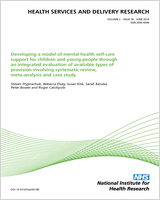NCBI Bookshelf. A service of the National Library of Medicine, National Institutes of Health.
Burton CR, Rycroft-Malone J, Williams L, et al. NHS managers’ use of nursing workforce planning and deployment technologies: a realist synthesis. Southampton (UK): NIHR Journals Library; 2018 Nov. (Health Services and Delivery Research, No. 6.36.)

NHS managers’ use of nursing workforce planning and deployment technologies: a realist synthesis.
Show details27 July 2017: helping managers to deploy the nursing workforce effectively
The chat was begun by discussing what approaches are used to indicate staffing availability and capability. There use of computer printouts, and managers visiting wards, to determine staffing had been observed. Others talked about templates, spreadsheets and boards displaying the number of staff on duty. The chat then moved to people’s experience of staffing tools or technologies, which included apps, web-based rotas and live acuity reporting. Many had experience of e-rosters. One commenter highlighted that a web-based rota can be logged into by staff to view and book shifts. However, others had no remote access to a rota and used written templates, which are constantly adjusted and can become difficult to read.
The dynamic nature of staffing in the light of patient need was emphasised and related to acuity assessments:
Some day optimal staffing isn’t enough, some days it is.
In some areas, the Safer Nursing Care tool or other assessment measures are ‘bolted on’ to e-rostering. The flexibility of tools and technology was important. The chat host wondered if e-rosters are referred to when changes occur. Participants suggested that there is a need for technology to be flexible to real-time demand, particularly when patient needs are rapidly changing. Community caseload tools should capture routine and unscheduled work, plus travel time.
The chat audience emphasised using technology alongside professional judgement, noting the challenges of balancing real-time needs with expertise and system advice. Determining skill mix in accordance with patient need is vital, but it is difficult with low staffing levels. Managers must account for staff sickness and student needs, and they must know the escalation policy. The costs of agency and bank staff were also a focus. Professional judgement can be developed through reflection within a supportive environment. Managing staffing is stressful, particularly moving staff. Knowing staff preferences to achieve a work–life balance is important.
The discussion moved to the pros and cons of tools/technology. A strong theme was standardisation versus flexibility. Staffing levels can be instantly available and this can save time. Tools were quick and straightforward for booking agency staff. However, solutions were not always provided, and tools and technology are not always staff-friendly or do not always connect demand to capacity well. In some instances, tools may not account for patient complexity. As one commentator summarised:
Always helpful to have tools but only as good as the info that is input and don’t replace the expertise of a qualified nurse.
There were examples of local use. Texts, WhatsApp Messenger (WhatsApp Inc., Mountain View, CA, USA) or Facebook were used to connect staff looking for shifts. A live mobile phone app enabled real-time recorded shift swap. The development of an in-house designed app was shared. On discussing education, concerns were raised that some people are not technologically savvy. Nurse involvement in the creation of technology is therefore vital for effectiveness in supporting practice. Tools and technology should be developed for intuitive use and balanced with training and support. E-rostering helps to ensure that education updates are built into the off-duty:
. . . a little bit of training unlocked so much power and saved me time.
Further information on this discussion can be found via the following link: www.wecommunities.org/tweet-chats/chat-details/3029
- WeChat#WeNurses summary - NHS managers’ use of nursing workforce planning and de...WeChat#WeNurses summary - NHS managers’ use of nursing workforce planning and deployment technologies: a realist synthesis
Your browsing activity is empty.
Activity recording is turned off.
See more...